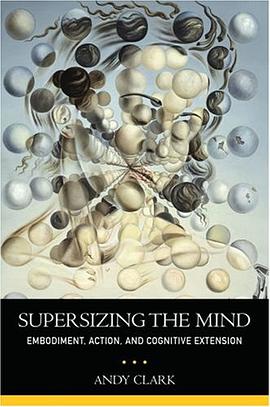
Embodiment, Action, and Cognitive Extension
Andy Clark
簡介
When historian Charles Weiner found pages of Nobel Prize-winning physicist Richard Feynman's notes, he saw it as a "record" of Feynman's work. Feynman himself, however, insisted that the notes were not a record but the work itself. In Supersizing the Mind , Andy Clark argues that our thinking doesn't happen only in our heads but that "certain forms of human cognizing include inextricable tangles of feedback, feed-forward and feed-around loops that promiscuously criss-cross the boundaries of brain, body and world." The pen and paper of Feynman's thought are just such feedback loops, physical machinery that shape the flow of thought and enlarge the boundaries of mind. Drawing upon recent work in psychology, linguistics, neuroscience, artificial intelligence, robotics, human-computer systems, and beyond, Supersizing the Mind offers both a tour of the emerging cognitive landscape and a sustained argument in favor of a conception of mind that is extended rather than
"brain-bound." The importance of this new perspective is profound. If our minds themselves can include aspects of our social and physical environments, then the kinds of social and physical environments we create can reconfigure our minds and our capacity for thought and reason.
contents
Foreword by David Chalmers ix
Introduction: BRAINBOUND Versus EXTENDED xxv
I: FROM EMBODIMENT TO COGNITIVE EXTENSION
1. The Active Body 3
1.1 A Walk on the Wild Side 3
1.2 Inhabited Interaction 9
1.3 Active Sensing 11
1.4 Distributed Functional Decomposition 13
1.5 Sensing for Coupling 15
1.6 Information Self-structuring 17
1.7 Perceptual Experience and Sensorimotor Dependencies 22
1.8 Time and Mind 23
1.9 Dynamics and “Soft” Computation 27
1.10 Out from the Bedrock 28
2. The Negotiable Body 30
2.1 Fear and Loathing 30
2.2 What’s in an Interface? 31
2.3 New Systemic Wholes 33
2.4 Substitutes 35
2.5 Incorporation Versus Use 37
2.6 Toward Cognitive Extension 39
2.7 Three Grades of Embodiment 42
3. Material Symbols 44
3.1 Language as Scaffolding 44
3.2 Augmenting Reality 45
3.3 Sculpting Attention 47
3.4 Hybrid Thoughts? 50
3.5 From Translation to Coordination 53
3.6 Second-order Cognitive Dynamics 58
3.7 Self-made Minds 59
4. World, Incorporated 61
4.1 Cognitive Niche Construction 61
4.2 Cognition in the Globe: A Cameo 63
4.3 Thinking Space 64
4.4 Epistemic Engineers 66
4.5 Exploitative Representation and Wide Computation 68
4.6 Tetris: The Update 70
4.7 The Swirl of Organization 74
4.8 Extending the Mind 76
4.9 BRAINBOUND Versus EXTENDED: The Case So Far 81
II: BOUNDARY DISPUTES
5. Mind Re-bound? 85
5.1 EXTENDED Anxiety 85
5.2 Pencil Me In 85
5.3 The Odd Coupling 86
5.4 Cognitive Candidacy 89
5.5 The Mark of the Cognitive? 92
5.6 Kinds and Minds 93
5.7 Perception and Development 99
5.8 Deception and Contested Space 102
5.9 Folk Intuition and Cognitive Extension 105
5.10 Asymmetry and Lopsidedness 106
5.11 Hippo-world 109
6. The Cure for Cognitive Hiccups (HEMC, HEC, HEMC . . .) 111
6.1 Rupert’s Challenge 111
6.2 The HEC Versus the HEMC 112
6.3 Parity and Cognitive Kinds, Again 114
6.4 The Persisting Core 116
xxii contents
6.5 Cognitive Impartiality 118
6.6 A Brain Teaser 122
6.7 Thoughtful Gestures 123
6.8 Material Carriers 126
6.9 Loops as Mechanisms 129
6.10 Anarchic Self-stimulation 131
6.11 Autonomous Coupling 133
6.12 Why the HEC? 135
6.13 The Cure 138
7. Rediscovering the Brain 140
7.1 Matter into Mind 140
7.2 Honey, I Shrunk the Representations 141
7.3 Change Spotting: The Sequel 143
7.4 Thinking About Thinking: The Brain’s Eye View 146
7.5 Born-again Cartesians? 149
7.6 Surrogate Situations 152
7.7 Plug Points 156
7.8 Brain Control 159
7.9 Asymmetry Arguments 162
7.10 EXTENDED in a Vat 163
7.11 The (Situated) Cognizer’s Innards 165
III: THE LIMITS OF EMBODIMENT
8. Painting, Planning, and Perceiving 169
8.1 Enacting Perceptual Experience 169
8.2 The Painter and the Perceiver 170
8.3 Three Virtues of the Strong Sensorimotor Model 172
8.4 A Vice? Sensorimotor (Hyper)sensitivity 177
8.5 What Reaching Teaches 180
8.6 “Tweaked” Tele-assistance 187
8.7 Sensorimotor Summarizing 190
8.8 Virtual Content, Again 193
8.9 Beyond the Sensorimotor Frontier 195
9. Disentangling Embodiment 196
9.1 Three Threads 196
9.2 The Separability Thesis 198
9.3 Beyond Flesh-eating Functionalism 200
9.4 Ada, Adder, and Odder 202
9.5 A Tension Revealed 204
9.6 What Bodies Are 206
contents xxiii
9.7 Participant Machinery and Morphological Computation 207
9.8 Quantifying Embodiment 213
9.9 The Heideggerian Theater 216
10. Conclusions: Mind as Mashup 218
Appendix: The Extended Mind, by Andy Clark and David Chalmers 220
Notes 233
References 255
Index 277

